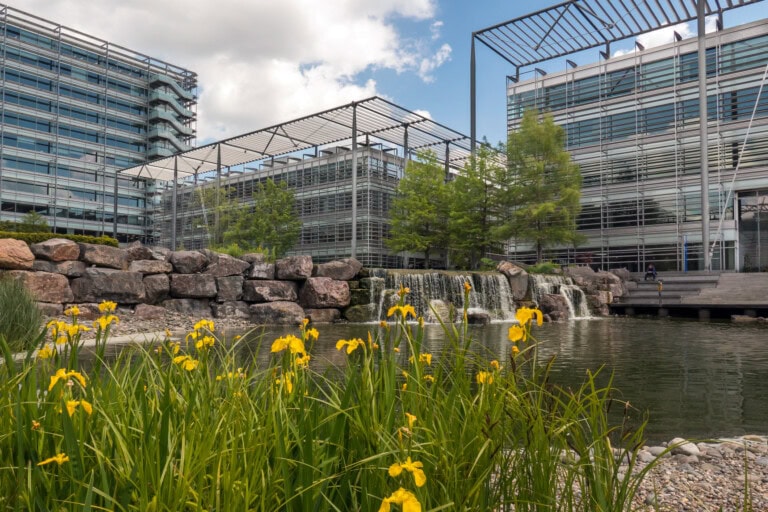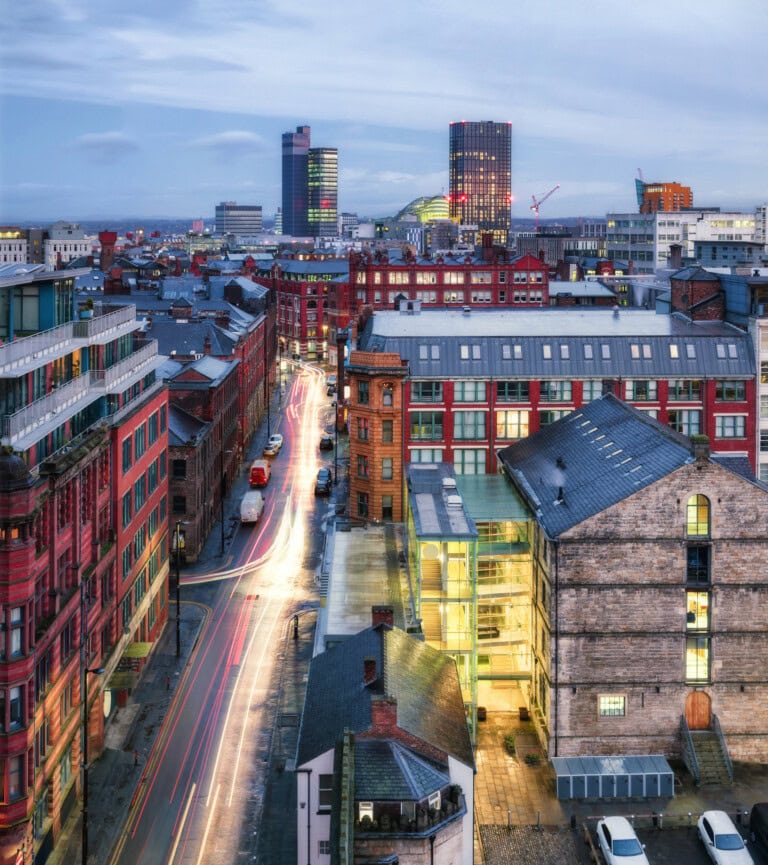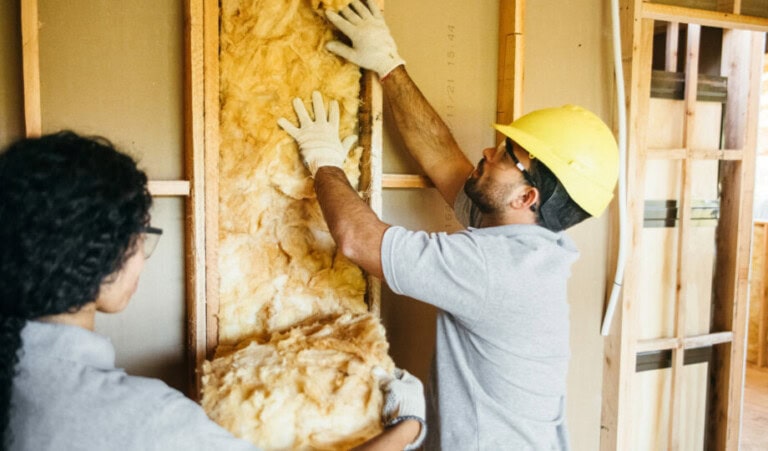Reflecting on COP28: Insights from UKGBC’s delegation to Dubai

As COP28 ends for another year, UKGBC’s Smith Mordak and Simon McWhirter, who were on the ground in Dubai, reflect on progress made at COP and what the built environment must do next.
What were UKGBC’s expectations and goals for the built environment at COP28?
Simon: COPs are the epitome of a marathon not a sprint; but as climate and ecological damage escalates and accelerates, we always hope and need to see real strides forward at COP, with clarity, commitment and the necessary collaboration to deliver. So, we enter into it with that glass-half-full approach.
With the Global Stocktake this year highlighting how far off the carbon reduction trajectory we are, this COP was a significant moment-in-time – a global gathering of the world’s national representatives and key, non state actors– where the impact and decisions are largely made by those in the room; those who are present.
So both as representatives of our member base, and as partners in the World Green Building Council network, we went to help drive the positioning of the built environment as a real climate solutions provider; indeed painting its importance of the nexus role of buildings in the carbon / resilience / nature / societal opportunity space. And if we’re being honest, to really throw our energy at working with partners to help establish more of bulwark on our domestic scene against the current backsliding of UK government green policy – so working hard to demonstrate both the best practice activity of our members and partners, and also to highlight our comparative positioning in the UK versus more progressive states.
Can you highlight some key achievements or positive outcomes for the built environment during COP28?
Smith: COP28 saw a raft of new pledges that we working in the built environment will have a role in meeting: the pledge to triple renewables and double energy efficiency by 2030; the pledge to reduce emissions from cooling to less than a third by 2030; the commitment to increase the use of wood from sustainably managed forests in construction; the commitment to adopt timebound commitments to procure low emission steel, cement, and concrete. None of these will be met without shifts in our sector, not to mention pledges on health, food, education and more that are all interconnected with buildings in the transition to a fair and sustainable future.
Simon: Agreed. We’ll pick up on the deficiencies of COP28’s outcomes obviously, but it’s also good to recognise that many of these are substantive and significant steps forward in the climate fight. Although a bit like historical school reports – “Some good progress, but lots of room for improvement”
When we turn to our particular bailiwick of the built environment, we can of course champion the launch of the Buildings Breakthrough – this commits to “near-zero emissions and resilient buildings being the new normal by 2030”. There’s an abundant lack of clarity there, but plenty to work with and take heart from – not least that it’s the first time the COP outcomes will formally recognise our buildings as such as critical part of the solution. Which in turn gives as weight to amp up the role of buildings, as countries look to enhance and improve their NDCs for the early 2025 deadline.
And it would feel remis not to just note what a privilege it is to be at – and involved in – COP. It’s been eye opening to mix with delegates from across the globe and hear their stories of the impacts climate change is having on their communities as well as the positive solutions being put forward.
What were the broader wins of COP28? Not just for the built environment but for us all globally.
Smith: I do feel the conversation has shifted over the last few COPs. We do now have a Loss and Damage Fund, we do have recognition of the interconnectedness of climate change and health, we do have a commitment to sustainable agriculture, we do now have a built environment day and buildings firmly on the agenda. But we’re still arguing over when or even whether we need to stop burning fossil fuels, still arguing over whether adaptation and recovery finance should be loans or grants, still arguing over how much to rely on carbon capture and other technologies whose efficacy and unintended consequences are untested. There are more indigenous voices at COP, but calls for deep connection with nature and collective action commensurate with the immensity of the existential threat we all face remain largely unheard.
What more did we want to see at the conference that was missed, and why do you think we didn’t get there?
Simon: Smith’s covered a lot of this already. So for example, while at a macro level the establishment of a Loss and Damage Fund is excellent; only by filling its coffers properly and ensuring its appropriately calibrated to deliver the right quanta of money rapidly into the right places – with minimal strings attached – will it support and transform places, lives and livelihoods the way envisaged. In fact, much greater climate finance commitments are needed all round.
And while the mass-agreement on diametrically enhancing the delivery of renewables and improved energy efficiency by 2030 is again one of our big asks, it’s left deficient by the third element of the triptych being overly weak – that is, the phasing out of fossil fuels. Summed up elegantly, but sadly, by the Samoan delegate: “The process failed us.”
Then, what’s next? For business, for government, and for individuals?
Simon: Practically, what’s next in this space for the built environment is that there will be a Buildings and Climate Global Forum in Paris next year, the first time Minsters from across the world are convening to address the challenges and opportunities afforded by the buildings and construction sector. So the spotlight’s on our sector more than ever, and we’ll need to step up and help frame the way forward.
And then on to COP29, now confirmed in Azerbaijan – good that the host nation is at last confirmed, but with another big fossil fuel state as host, we’re likely to face more ramping up of the oil and gas lobby group again.
Smith: On an individual level, can we think differently? Can we intentionally look for commonalities between things we’ve historically pitted against each other? It’s easy to pit timber for construction against habitat conservation, but regenerative agroforestry can facilitate synchronicity between feeding and creating habitats for humans and more-than-humans alike.
Can we imagine transition plans where things are in flux instead of fixed; shifting instead of static? Decarbonising construction while addressing the housing crisis can feel impossible, but if the goal is to ensure everyone has access to safe and secure housing, there are more ways to transition from where we are now towards that goal than by building hundreds of thousands of carbon-intensive new homes in some of the most expensive areas of the country.
How can UKGBC Members get involved and drive climate action post COP28?
- Embrace your individual capabilities for sustainability leadership and sign up to one of our transformational leadership programmes in 2024. Whether that’s Future Leaders for those early in their career, or Recalibrate for C-Suite individuals.
- Build your knowledge on key sustainability topics by exploring our resources or signing up for one of our learning courses in the new year – for example, January’s How to Procure Renewable Energy in the Built Environment course.
- Use your voice to call for policy changes that will drive climate action in the built environment. Not sure where to start? Join UKGBC’s event in January to learn more about the Future Homes Standard, help inform our response to the live consultation and understand how you can be involved in a bigger campaign.
Related
Sustainable Construction for the Sustainable Development Goals

What is Operational Carbon in buildings?

Retrofit: Operational energy in the spotlight

How time-matching and location-based energy procurement reduces emissions while improving Scope 2 reporting

